Intro
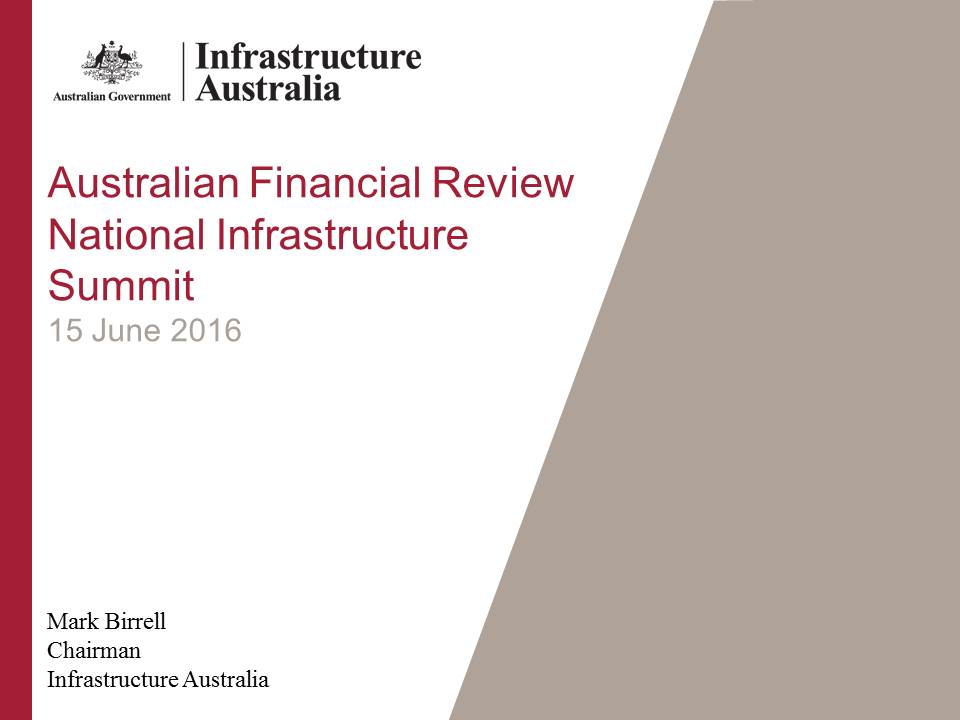
I congratulate the AFR for again organising this National Infrastructure Summit. This event draws governments, industry and the wider community into a valuable discussion of what we need from our infrastructure.
The next two days will be an important opportunity for a productive public dialogue about the infrastructure that Australians want, the outcomes it should deliver and the best ways to plan and pay for it.
If we are going to improve Australia's living standards and productivity, then infrastructure is vital.
Today—at the pointy end of a Federal Election campaign dominated by quick-fire media coverage of daily disputes—I want to make the case that our nation should take a strategic approach to the infrastructure Australia needs, focussing on the long-term needs of the consumers and users of our networks and utilities, our transport systems and our international gateways.

At the time of the release of Infrastructure Australia's Australian Infrastructure Audit—and the last time I spoke at this conference—IA identified ten strategic challenges facing the nation.
IA grouped these in our 15 year Australian Infrastructure Plan under four headline aspirations, to help chart a long term course that ensures Australia's national success story continues.
Those aspirations are: ‘Productive cities & productive regions’; ‘Efficient Infrastructure markets’; ‘Sustainable and Equitable Infrastructure’ and ‘Better decisions and Better delivery.’
These are a useful framework for understanding what Australia needs to consider if it is to meet its infrastructure challenges over the next 15 years and beyond. The aspirations may also be helpful to reflect on during your discussion over the next two days.
It is Infrastructure Australia's strong view that, as a country, we need to focus on the long game—to sustain Australia's economic growth and quality of life.
We must encourage a 15 year outlook, beyond electoral cycles, and a nation-wide strategy.
…and the context is obviously important; we're facing an environment of unprecedented change. Australia is changing, the world is changing, and we need to plan for it, if we are to take advantage of those changes.
Australia is changing
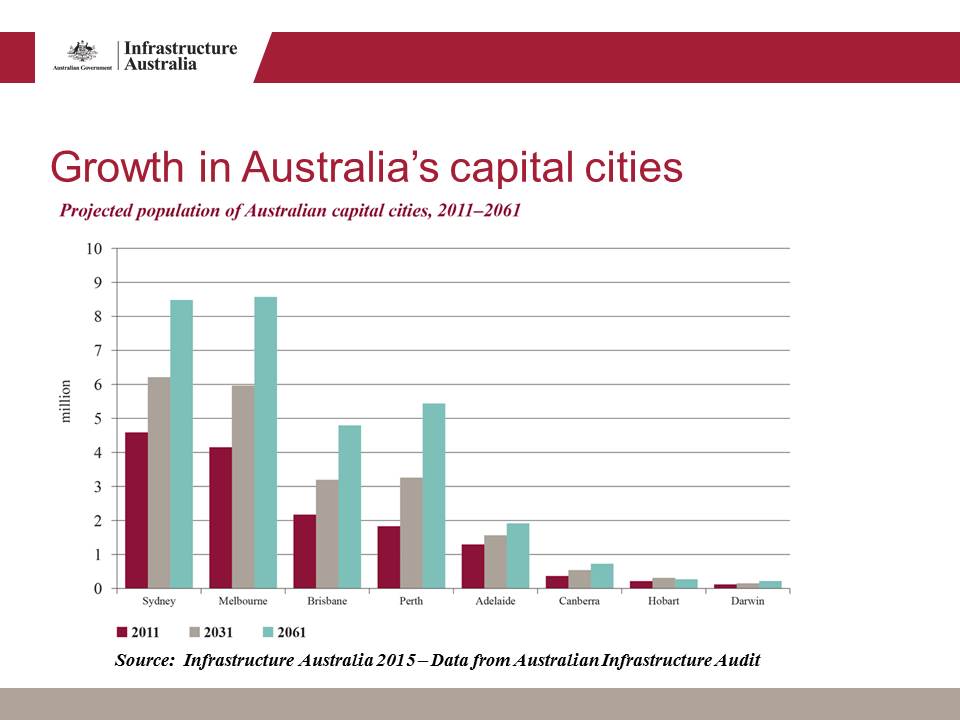
Let's start by looking how Australia's changing.
In February of this year, Australia's population hit 24 million people.
And when we released our Australian Infrastructure Audit last year we projected that, by 2031, the nation's population will grow to more than 30 million people.
Australia's population growth is now exceeding that of our peers, outstripping countries like the UK, Canada and the USA.
Between 2011 and 2031, three quarters of our growth will occur in the big four cities—Sydney, Melbourne, Brisbane and Perth.
Overall, our capital cities contributed $854 billion dollars to our economy in 2011. This is projected to grow by 90 percent to a contribution of $1.6 trillion in 2031.
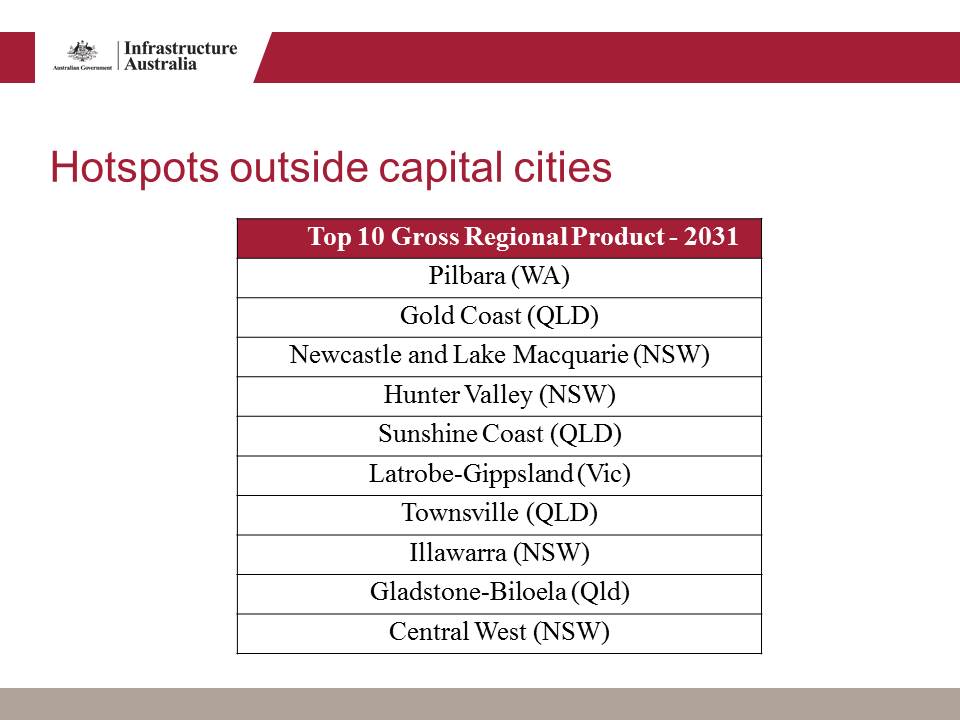
And the growth challenges are not just in capital cities.
Australia's regions already contribute substantially to the nation's growth and prosperity. Regional Australia produces many of our key exports—such as minerals, energy, agriculture and tourism.
There will be considerable economic and population growth in regional centres like the Pilbara, Gold Coast, Newcastle, the Hunter Valley and others.
Today, they contribute $44 billion dollars to the national economy, largely through resources and agricultural activities. By 2031 this is projected to more than double to $110 billion dollars.
We will need to focus our future infrastructure investment on supporting access to and growth in our regions and aim to get the most return nation-wide.
The world is changing
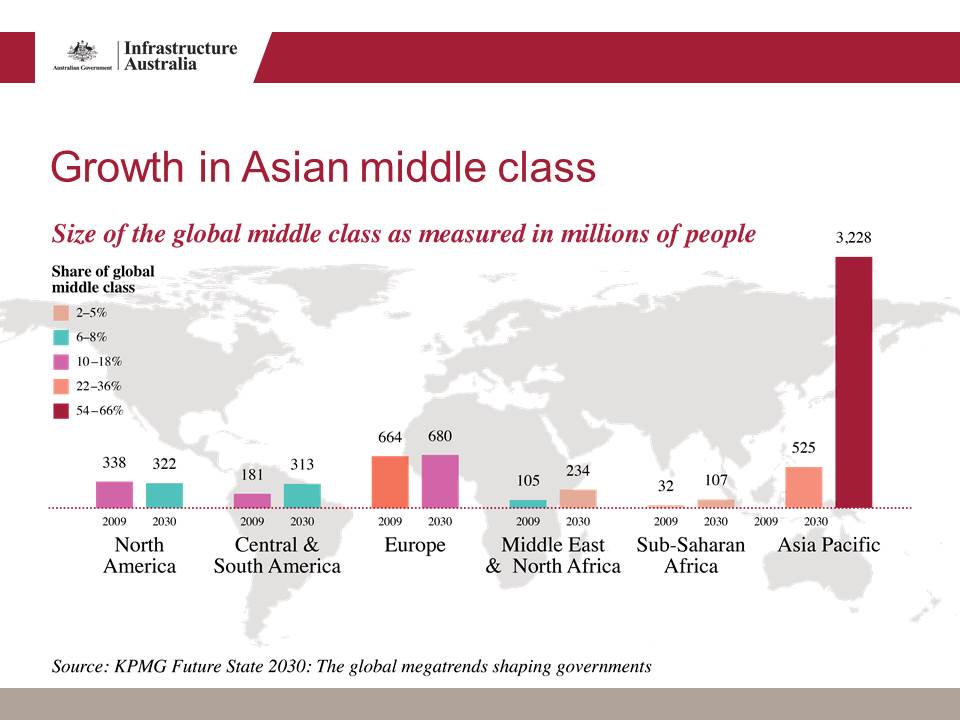
But, it's not just Australia that is changing.
The world at large is changing—there is a shift in global power to Asia. And since the mid-1980s, the pace of that shift—from the United States and Europe toward Asia— has been increasing dramatically.
This provides Australia with a global locational advantage, being one of a few nations in this growing region with an established reputation for both high quality goods and services.
We are uniquely able to service the emerging economies and middle-classes of China and India, in particular.
The Asian middle class will grow to be two thirds of the global middle class by 2031 and will demand more of our exports, tourism, education and other services.
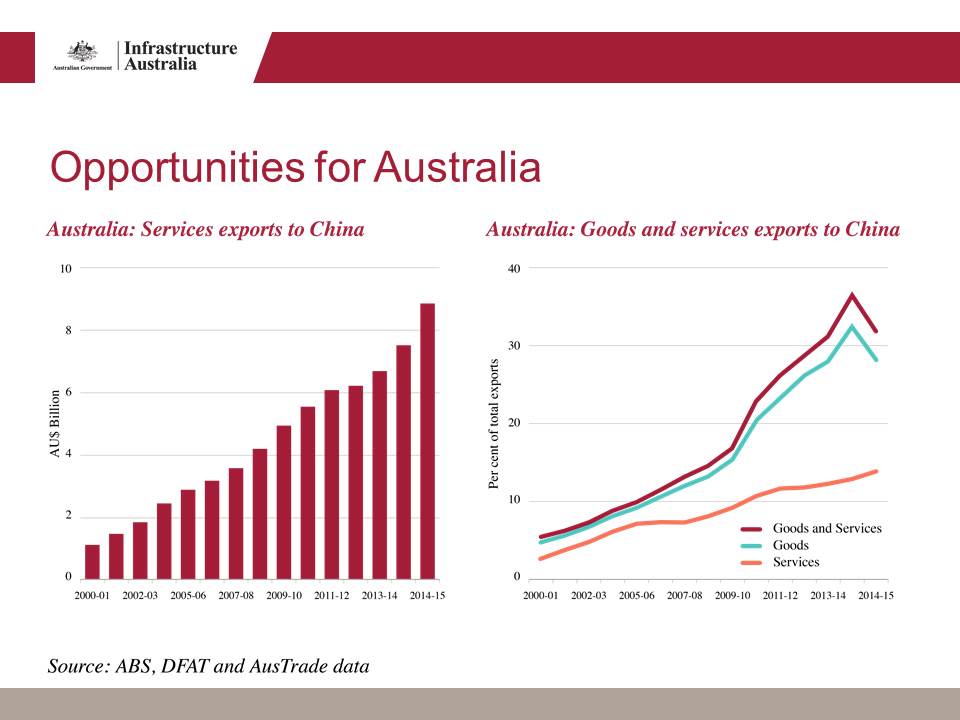
This is born out in our existing export numbers.
Although the recent iron ore price drop has meant that the value of total exports to China has fallen recently (by about 16%), the value of other exports and services has continued to grow.
And there are future opportunities for Australia to invest and develop businesses in Asia in areas as diverse as financial services, telecommunications, hospitality, transport and logistics.
We have an incredible opportunity to transition our economy from a mining-reliant boom, to a more diverse, multi-sector export economy of high quality goods and services.
However, we will not automatically be able to take advantage of the opportunities in our region. We must plan for it and move strategically to take advantage of it.
Our future success lies in expanding our engagement with the world and investing in our infrastructure at home to support it.
Productive cities, productive regions
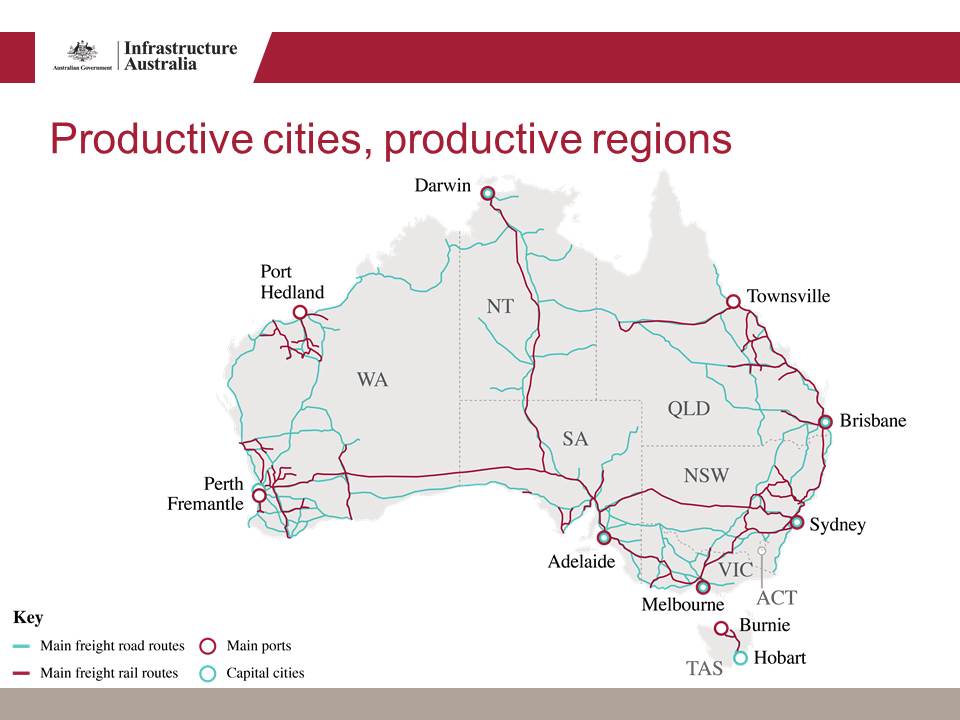
In order to grab this opportunity, we must have productive cities and productive regions.
We need to create 21st century supply chains—where we can move goods from our regions quickly to growing markets in Asia.
In our cities, where much of our economic output is generated, we need to ensure our greatest asset—human capital—is attracted to stay or come to Australia and can move around effectively and efficiently.
We're lucky that four of the top 10 "most liveable cities in the world" are in Australia. Our metric for success in the future should be to maintain this liveability while dealing with our growth.
It won't be easy and it will require dealing with clear challenges.
For instance, at a national level IA found that if we don't act, the cost of congestion in our capital cities, estimated at $13 billion in 2011, is expected to increase to around $53 billion in 2031.
Our freight task is projected to rise by 80 per cent between 2011 and 2031.
Our four largest cities—Sydney, Melbourne, Brisbane and Perth—will need to deliver about 500,000 to 700,000 additional dwellings over the next 15 to 20 years.
With population growth like we are projecting, there will be a clear need in our cities to rapidly increase the delivery of higher density housing. Successful higher densities should provide people with quality, affordable housing that is well-connected to infrastructure, community public spaces and world-class amenities.
Australia's largest cities should also plan for and deliver integrated, ‘turn up and go’ public transport services—similar to what is available in cities like New York, Singapore, London and Berlin.
One of the challenges I put to this audience today is to debate how best we ensure we maintain our liveability and our growth trajectory at the same time. We must do both.
In the Australia n Infrastructure Plan we recommended that one option could be for some of our smaller cities to actively attract population growth and thereby help spread the growth more evenly. How should Australia do that? What policy and regulatory changes should we make? What direct investments should be made?
Efficient markets
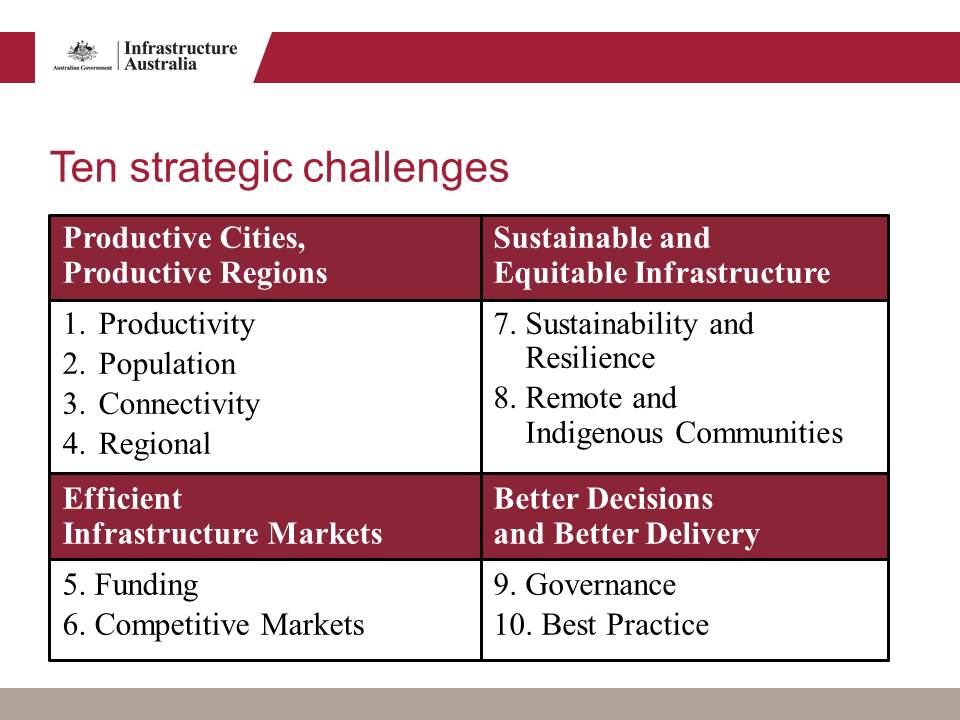
If we are to afford the infrastructure we need to support our cities and regions, we will need to be determined and innovative in how we fund and finance it.
Governments have a heavy responsibility, but cannot fund it all.
Australia will need to access more private sector financing, as the participation of the private sector brings with it commercial rigor and a powerful incentive for efficient delivery.
The challenge for governments is to structure projects such that they provide confidence to the private sector. Government infrastructure decisions therefore need to be guided by long-term planning, rigorous evidence and transparent engagement with the community.
And, importantly, proposed projects will need to identify a revenue stream, which can repay that investment plus a reasonable risk-weighted rate of return.
To ensure we are able to afford the infrastructure we need, governments and others will need to explain to the community what reforms or other steps are necessary to ensure we are able to fund the infrastructure we need.
One topic I hope is debated today is how we take the community on the journey .
Better decisions, better delivery
As I indicated earlier, we will not attract the private sector investment we need unless we ensure our infrastructure decision-making is made with a focus on effective governance. Even more importantly we will not be able to build the right, high-quality infrastructure that will allow us to take advantage of our many global opportunities.
Governments (Federal and State) have come a long way over the last decade, but still need to establish a more rigorous evidence base for infrastructure investment decisions.
IA believes the areas for focus include: increasing the quality and consistency of our long-term infrastructure planning, including corridor protection; allocating increased funding for project development work, such as feasibility studies and business cases; improving the transparency of decision-making and ensuring the consistent delivery (and publication) of post-completion reviews.
The infrastructure sector should also better capitalise on new technologies to improve the planning, delivery, and maintenance of infrastructure.
One example, that we advocated for in the Plan, is that governments should make use of Building Information Modelling (or BIM) mandatory for the design and delivery of large-scale, complex projects.
BIM enables the generation of three-dimensional models of buildings, infrastructure and places and assists in the design, delivery and operation phase of a piece of infrastructure.
A good example of BIM, here in Sydney, is its use for the North West Rail Link. Here they are using a web-based project management system specifically developed for the control and evaluation of data to efficiently manage the building and operation of the rail project.
During the current building phase a vast amount of data is generated, which will be embedded in workflows for direct project control and reporting and analysis.
During the course of the project, as this data is collected it is automatically linked to a 3D model, analysed and archived for future usage. This data is then able to more effectively manage the rail link, and improve its maintenance while it is operational.
The use of these systems is par for the course in other countries including the UK and Singapore. We should be considering how we can do the same.
A potential question for this audience to debate today is how do we best incentivise government departments and agencies to make these good decisions? To protect corridors, do post completion reviews, use the latest technology—to plan for the long term? It is critical that we do.
Sustainable and equitable infrastructure
Finally, we will need to ensure that our infrastructure is sustainable and resilient.
Energy and water providers should seek to improve sustainability by making better use of existing infrastructure, such as using technology to identify and minimise leaks and losses, to ultimately deliver lower prices for consumers.
Operators should make smarter use of transport networks by spreading peak demand or shifting passengers and freight to their most efficient mode, reducing time and costs for users.
Governments should continue to encourage innovation and growth in renewable and lower-emission technologies. Governments should work with the private sector to develop a cohesive strategy that supports a transition to lower emissions at the lowest cost to users and taxpayers.
I hope that in the debate over the next couple of days that thoughts and perspective are presented on how we can do more, keep the infrastructure we have for longer and improve it with the growth in technology.
Conclusion
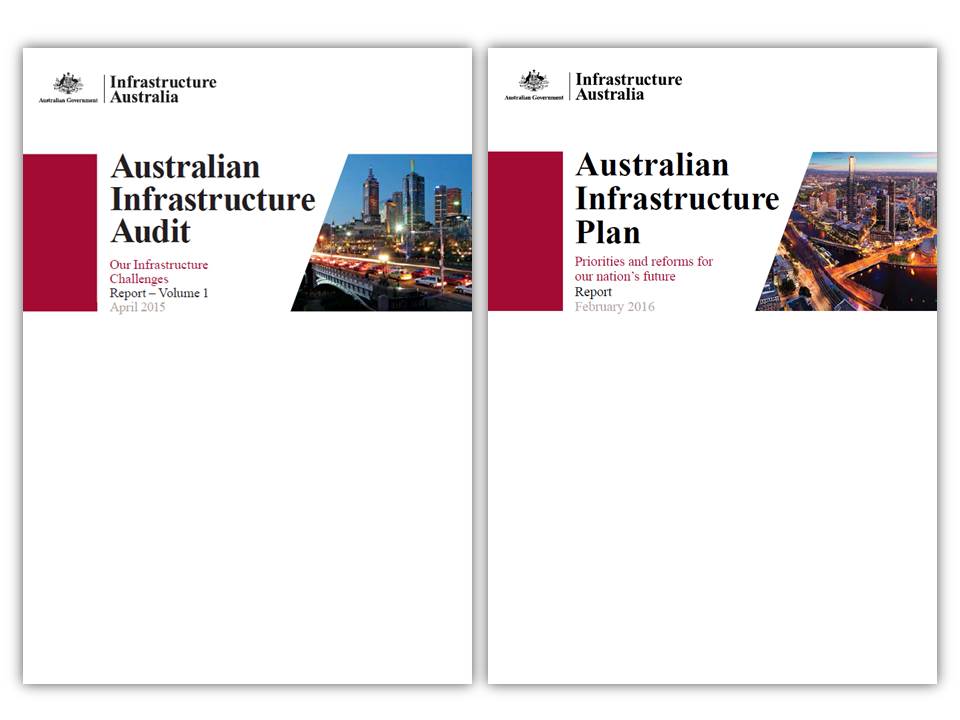
So, I hope that over the next two days we are able to keep this strategic focus in mind… that we are able to think strategically about what our aspirations are for Australia and its infrastructure. It's certainly what IA sought to encourage in both our Audit and Plan.
Infrastructure has to be conceived and developed with a long-term focus—avoiding the pitfalls where projects are debated in isolation and the generational needs of infrastructure users are ignored.
Consumers want infrastructure (be it new or modernised) that eliminates congestion and queues, which helps their lives and that of their families or co-workers. Businesses are looking for infrastructure that boosts their connectivity or cuts their costs, and allows them to compete globally.
So, as I said at the start of my address, it is the sustainable needs of consumers and users that should drive all government decision-making on infrastructure planning and operation.
I'm optimistic that an on-going national debate about our infrastructure future will see increased investment in new projects that transform our networks and gateways, and just as importantly will secure funding for integrated planning and the smarter operation of existing infrastructure.
It is critical that we do.
Thank you.